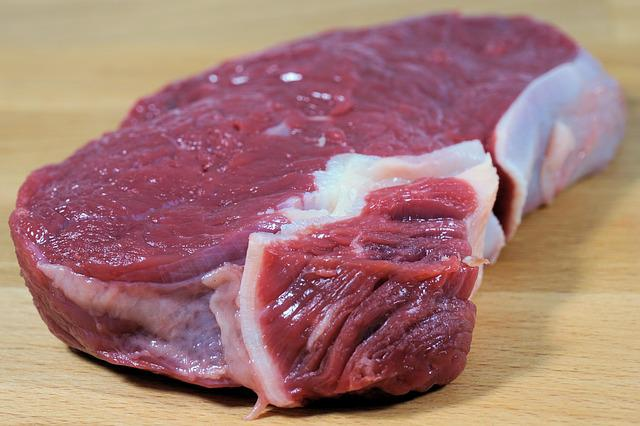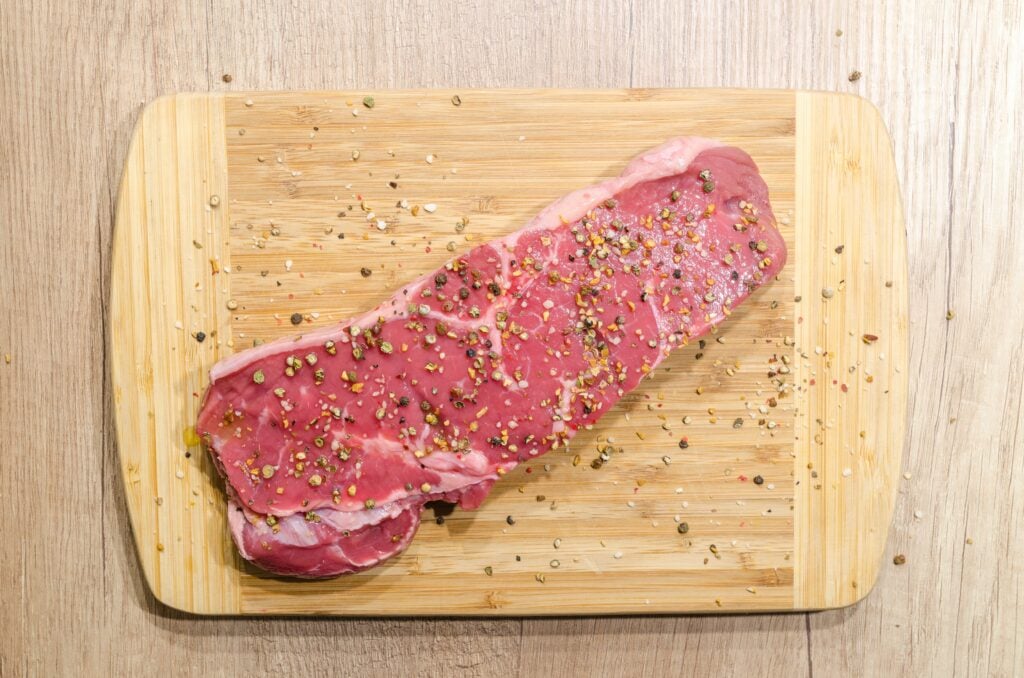There’s nothing more delicious than a perfectly cooked steak.
But is your steak fresh? What do you do if it’s been sitting around for a while?
You don’t have to guess.
There are some things you can do to ensure that you don’t eat spoiled steak and risk food poisoning!
How to tell if steak is bad: Tips For Healthy Grilling
Check the Expiration Date
It’s always a little bit of a gamble when you buy steak from the grocery store.
You can never really be sure how good the quality is going to be, and even if it looks good, there’s always the possibility that it’s gone bad.
Raw beef can turn into spoiled meat pretty fast if it’s not fresh!
So how can you tell if your steak is still good to eat?
The first and most obvious thing you should do is check the expiration date or the use by date.
Fresh steak from the store will likely either have a sell-by date or a use-by date.
If it’s past the “use by” date, then there’s a good chance that the meat has gone bad.
If it’s past the sell-by date, it doesn’t necessarily mean it’s a bad steak. The sell-by date is just there to guide the grocery store on when to sell it.
The use-by date is a guide for the consumer to know when it’s definitely safe to eat.
A delicious dry-aged steak is hard to beat if it’s fresh meat and has been cooked well.
However, eating a bad steak that has gone past its shelf life will at best give you an upset stomach, and at worst cause you a trip to the Emergency Room!

A bad smell
One of the easiest ways to tell if steak is bad is by giving it the smell test.
If the steak has a strong, off-putting odor, like strong cheese or rotten eggs. Or if it smells sour, then it has probably gone past its shelf life and should be thrown out.
However, if the steak just has a subtle off smell, then it may still be safe to eat.
Discoloration
Another way to tell if steak is bad is by looking at its color.
If the steak has turned a grayish-brown color then it has probably gone bad and should not be eaten.
However, if the steak just looks a little darker than usual, then it may still be safe to eat.
Ultimately, the best way to tell if steak is bad is to use your best judgment.
If the steak looks and smells fine, then it is probably safe to eat. But if the steak looks and smells bad, then it is probably best to throw it out.
Another thing to look at is how it feels.
Slimy steak is bad steak!
Mold
Look for signs of mold if you think that your frozen steak or raw steak is now spoiled steak!
Mold can appear as white, green, or black spots. The mold may also be fuzzy or have a powdery texture.
If you see any mold on your steak, it’s best to discard it.
Some types of mold can cause serious health problems if ingested.
If you’re not sure whether the mold is safe to eat, err on the side of caution and throw it out.
How do you store raw steaks?
Most people are unsure of how to properly store their steak, which often leads to the meat becoming freezer burned or going bad.
The key to storing steak is to keep it cold and dry.
Raw steak should be wrapped in butcher paper or stored in a sealed container in the refrigerator.
If you plan on freezing the steak, wrap it tightly in plastic wrap or aluminum foil. Be sure to label the steak with the date it was frozen.
Using a vacuum sealer to store your steak will ensure that it stays fresh and perfectly safe for the long run.
A vacuum-sealed bag will also protect your steak from freezer burn if you’re looking at long-term storage.
When cooking frozen steak, be sure to thaw it in the refrigerator overnight before cooking.
With proper storage, your steak will stay fresh and delicious.
How do you store cooked steak?
Steak can be stored in a number of different ways, depending on how it will be used.
For steak that will be eaten cold, such as in a steak sandwich, it is best to wrap it tightly in plastic wrap or in an airtight container and store it in the refrigerator.
Steak that will be reheated can be stored in the same way, or it can be placed in a covered dish.
Steak that will be used for stir-frying or another hot preparation should be cut into thin strips before being stored.
Steak can also be frozen for longer-term storage; wrappers or containers should be labeled with the date before the steak is placed in the freezer.
For thawed steak, it’s important to thaw it slowly in the refrigerator to prevent the growth of bacteria.
It’s Dried Out
If you’re not sure whether your steak is dried out, there are a few things you can look for.
First, check the color of the steak. If it’s significantly darker than when you bought it, that’s a bad sign.
Raw steak will be dark red. If it’s beginning to change color to dark brown it might still be ok. However, if it’s changed to gray or green then it’s likely well past the use-by date or sell-by date and is a definite sign that the steak is bad.
Second, feel the steak. If it’s significantly harder than when you bought it, that’s another bad sign.
Also, if the raw steak feels slimy, then the steak has gone bad and is full of harmful bacteria.
Finally, smell the steak.
If it smells sour or rancid, that means it’s gone bad and you should throw it out.
If you’re still not sure, err on the side of caution and throw it out. It’s better to be safe than sorry when it comes to spoiled food!
Will thawing and freezing steak cause it to go bad?
Will thawing and freezing steak cause it to go bad?
The quick answer is no.
You can freeze steak for up to 12 months without it losing any flavor or quality.
In fact, freezing steak is a great way to extend its shelf life.
However, there are a few things to keep in mind.
First, steak that has been frozen and then thawed is best used within 3-4 days.
Second, steak that has been frozen and then thawed may be slightly tougher than fresh steak.
This is because the freezing process breaks down some of the muscle fibers.
However, this shouldn’t affect the flavor of the steak.
So go ahead and freeze your steak! It will still be delicious when you thaw it and cook it.
However, refreezing steak that has already been thawed isn’t a good idea. Although it’ll be safe to eat, it won’t taste very good.
Frozen steaks are perfectly fine, but frozen, then thawed, and refrozen isn’t a good idea.
What happens if you eat spoiled steak?
Spoiled steak is not something you want to eat.
It can cause food poisoning, which is no fun for anyone.
The symptoms of food poisoning can include nausea, vomiting, diarrhea, and stomach cramps.
In severe cases, food poisoning can lead to dehydration and even death.
So it’s best to avoid eating spoiled steak altogether. Remember, it’s always better to be safe than sorry!
How do I keep my steaks fresh?
Here are a few tips on keeping your steaks fresh.
- Steak should be stored in the fridge, wrapped in aluminum foil or plastic wrap.
- If you’re not going to cook the steak right away, you can FREEZE it. Just make sure to wrap it tightly in a freezer-safe wrap or place it in an airtight container.
- Most steaks will stay fresh for 3-5 days in the fridge, and up to 6 months in the freezer.
- When you’re ready to cook your steak, make sure to thaw it completely before cooking. The best way to do this is to leave it in the fridge overnight.
By following these simple tips, you can enjoy a perfect steak that is fresh and flavorful.
Final thoughts – How to tell if steak is bad?
So how can you tell if your steak has gone bad?
There are a few ways to tell – hopefully this article has informed you of some of those ways.
One important thing to note, this article is specifically about beef steak and doesn’t cover other meats like plant-based steak or even tuna steak.
At the end of the day, it comes down to your senses. Does it smell bad? Does it look bad? Does it feel bad? If any of those are bad, then the steak has gone bad.
Those are the easiest ways how to tell if steak is bad.
Related Posts
-
How to tell if bacon is bad
How can you tell if your bacon is fresh bacon or bad bacon? There are…
-
Is baking powder bad for you?
Is baking powder bad or good for your health? Baking powder is a common ingredient…
-
How long is tuna salad good for
Does Tuna Salad go bad? Tuna salad is a staple of a lot of restaurants…






